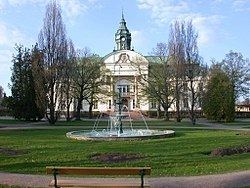County Östergötland County Time zone CET (UTC+1) Population 29,823 (31 Dec 2010) Clubs and Teams Motala AIF, IFK Motala | Province Östergötland Municipality Motala Municipality Area 19.18 km² Local time Sunday 2:26 PM | |
 | ||
Weather 6°C, Wind SE at 14 km/h, 40% Humidity Points of interest Motala Motor Museum, Motala ström, Motala Turistbyrå, Charlottenborg manor house, Varamobadet | ||
Motala dashcam 17 bad drivers distracted drivers dumping caravans and more
Motala is a locality and the seat of Motala Municipality, Östergötland County, Sweden with 29,823 inhabitants (41,956 in the entire municipality) in 2010. It is the third largest city of Östergötland, following Linköping and Norrköping. Motala is situated on the eastern shore of Lake Vättern and is regarded as the main centre of both the Göta Canal and the surrounding lake region.
Contents
- Motala dashcam 17 bad drivers distracted drivers dumping caravans and more
- Map of Motala Sweden
- Motala dashcam 20 accident bad driving and more
- History
- Longwave radio
- Main sights
- Sports
- References
Map of Motala, Sweden
Motala dashcam 20 accident bad driving and more
History
Motala Church dates from the 13th century. For several centuries, Motala remained a small village, mainly regarded as a stopping post on the road to the nearby town of Vadstena, one of cultural centres of medieval Sweden. However, King Gustav Vasa had a manor house built at Motala and later Queen Kristina had a summer residence built at the spa resort of Medevi, 20 km north of the town.
When the Göta Canal was built in the early 19th century, Motala became an important town for the trade on the canal. The builder of the canal, Baltzar von Platen has his grave beside it. The town received the minor privilege status of köping in 1823, while full city rights were granted as of April 1, 1881. With the Swedish municipal reform of 1971, Motala became the seat of Motala Municipality.
Motala Verkstad is an engineering company, world famous for its bridge and railway construction equipment. In the science fiction novel 20,000 Leagues Under the Sea by Jules Verne, the prow of the submarine Nautilus was built at Motala Verkstad. Later major Swedish industrial manufacturers such as Electrolux and Luxor had their main factories built in the city.
In 1963, Tetra Pak installed the first Tetra Brik packaging machine in Motala.
Longwave radio
Another important episode of Motala history began in 1927, when the Swedish national Motala longwave transmitter station was built. The town marks the middle of a straight line between Sweden's two biggest cities, Stockholm and Gothenburg. Radio programs were transferred from studios in Stockholm to Motala by telephone wire. The call was "Stockholm-Motala". The transmitter operated on 191 kHz until 1962, when the transmissions were moved to Orlunda. Since 1991 there have been no longwave transmissions at all by the Swedish Broadcasting Company, but the Motala transmitter, which is a museum today, sometimes makes low power transmissions which may only be receivable in the Motala area.
At Ervasteby, near Motala, there is a 332 metres tall guyed mast, used for FM- and TV-broadcasting.
Some years before the broadcasting station was established the company Luxor was founded in Motala. Luxor soon became one of the largest radio, and later television, manufacturers in Sweden. In the 1980s Luxor started producing their own line of computers, like the ABC 80. In 1985 Luxor was acquired by Nokia, and eventually production moved elsewhere.
Main sights
For sights surrounding Motala, see Motala Municipality.
Sports
The following sports clubs are located in Motala:
